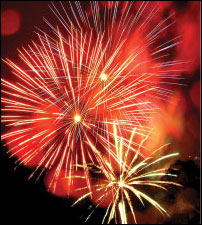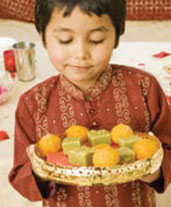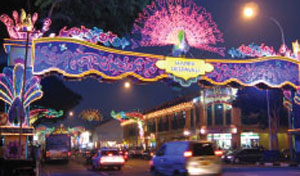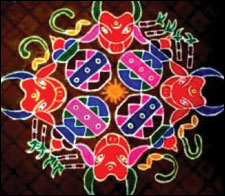|
The Festival of Lights:
Its glow never fades
The bright lights that illuminated our beloved Motherland just
yesterday as our Hindu brothers and sisters celebrated one of the
biggest festivals in their Hindu calendar, Deepavali, are still aglow,
spreading their brilliance and warmth everywhere.
Due to the nearly three decade ethnic conflict that dampened the
spirits of the Tamil people, most Hindus celebrated this significant
festival with a heavy heart over
 the
past years... However, now that our Motherland has been freed from the
jaws of terrorism, and bridges of lasting peace are now being built
between the two main ethnic communities that once looked at each other
with suspicion and fear, Deepavali or Diwali as it is also known, was
celebrated throughout the land with great joy in a grandiose manner this
year.. It is indeed one of the biggest Hindu festivals and is called the
Festival of Lights (deep = light and avali = a row i.e. a row of lights)
because of the many lamps that are lit on this day. the
past years... However, now that our Motherland has been freed from the
jaws of terrorism, and bridges of lasting peace are now being built
between the two main ethnic communities that once looked at each other
with suspicion and fear, Deepavali or Diwali as it is also known, was
celebrated throughout the land with great joy in a grandiose manner this
year.. It is indeed one of the biggest Hindu festivals and is called the
Festival of Lights (deep = light and avali = a row i.e. a row of lights)
because of the many lamps that are lit on this day.
Even though it's celebrated just for a day in our country, in India
and most other parts of the world it is generally marked by five days of
celebration, which literally illumines the country with its brilliance
and dazzles all with its joy.
The days of celebrations in the festival are separated by a different
traditions, but the essence of it all is the celebration of life, its
enjoyment and goodness.

How many of you participated in the celebration of this significant
festival yesterday? Didn't you think the lighting of so many lamps was
simply fantastic? Perhaps the glow of these lights would embrace us all
even in the coming days and dispel the darkness that kept the
communities apart.
Some of you may be aware of the origin of the festival, but there may
be others who are not. So, let us trace the origin and enlighten
ourselves about this festival which is very significant to our Hindu
brethren.
Historically, the origin of Deepavali can be traced back to ancient
India. It is believed that during that time it was probably only an
important harvest festival. However, there are various interesting
legends surrounding the origin of this festival.
While some believe it to be the celebration of the marriage of
Lakshmi with Lord Vishnu, there are others who commemorate the return of
Lord Rama along with Sita and Lakshman from his fourteen year long
exile, vanquishing the demon-king Ravana on this day.
It is said that the people of Ayodhya, the capital of Rama, were so
ecstatic at the return of their beloved king that they illuminated the
kingdom with earthen diyas (oil lamps) and burst crackers in
celebration.
In another part of India, in Bengal to be precise, the festival is
dedicated to the worship of Mother Kali, the Goddess of Strength. Lord
Ganesha, the elephant-headed God, the symbol of auspiciousness and
wisdom, is also worshipped in most Hindu homes on this day.
As it is not only the Hindus who celebrate this festival we need to
examine what it signifies to others also.
It is a significant festival in Hinduism, Sikhism, and Jainism, and
an official holiday in India.
In Hinduism, across many parts of India and Nepal, it is the
homecoming of Rama after a 14-year exile in the forest and his victory
over Ravana.
In the legend, the people of Ayodhya (the capital of his kingdom)
welcomed Rama by lighting rows of lamps , thus its name. Over time, this
word transformed into Diwali in Hindi and Deepavali in Nepali, but still
retained its original form in South and East Indian
languages.Accordingly in Jainism, Deepavali has an added significance to
the great event of Lord Mahavira attaining the Eternal Bliss of Nirvana.
 Deposal
festival may be steeped in simple rituals if one were to compare them
with some of the more elaborate rituals, of some other festivals, but
all the simple rituals have a significance and a story to tell. Deposal
festival may be steeped in simple rituals if one were to compare them
with some of the more elaborate rituals, of some other festivals, but
all the simple rituals have a significance and a story to tell.
Most often when firecrackers are lit at other religious or national
events, we do not pay much heed to its significance, but when it comes
to lighting firecrackers on Deepavali it is a different story.
The illumination of homes with lights and the skies with firecrackers
is an expression of obeisance to the heavens for the attainment of
health, wealth, knowledge, peace and prosperity.
It is believed by some that the sound of firecrackers are an
indication of the joy of the people living on Earth, making the gods
aware of their plentiful state.
In each legend, myth and story of Deepavali lies the significance of
the victory of good over evil; and it is with each Deepavali and the
lights that illuminate our homes and hearts, that this simple truth
finds new reason and hope.
From darkness unto light, the light that empowers us to commit
ourselves to good deeds, that which brings us closer to divinity.
During Deepavali, lights illuminate everywhere and the scent of
incense sticks hangs in the air, mingled with the sounds of
firecrackers, joy, togetherness and hope. Especially for a peaceful
Motherland now that the war is fading into just a horrible memory.
Earthen lamps may have been replaced with stunning electric
illuminations, dress code may have changed, but the custom and tradition
of performing puja has been carried very well through generations.
People wake up at the crack of dawn to conduct the customary pujas.
Dressed in brilliant silks and glittering gold jewelry families gather
and light crackers to usher in the great evening. After a session of
bursting crackers, its time to visit friends and relatives. Armed with
sweets and savouries people meet their near and dear ones.
Even today, Deepavali is such a wonderful festival, a time of giving
and sharing, a time to catch up with people, in other words its time to
catch up with the little joys that we keep overlooking for the remaining
part of the year.
Five days of Deepavali
Deepavali is a festival of joy, splendour, brightness and happiness.
It is the festival of lights and is celebrated with great enthusiasm by
Hindus all over the world.In most parts of the world, especially in
India it is a festival that spreads over five days. In Our country
however, people generally celebrate only for day... And this year
Deepavali fell on October 17.

The uniqueness of this festival is its harmony of five varied
philosophies, with each day to a special thought or ideal. People
celebrate each of its five days of festivities with true understanding,
in the belief that it will uplift and enrich the lives.
The first day : Dhanteras
The second day: Choti Diwali
The third day : Lakshmi Puja on Diwali
The fourth day : Padwa and Govardhan Puja
The fifth day : Bhai Duj
Fast facts:
* Deepavali is a festival where people from all age groups
participate.giving expression to their happiness by lighting earthen 'diyas'
(lamps), decorating the houses, bursting firecrackers and inviting near
and dear ones to their households for partaking in a sumptuous feast.
The lighting of lamps is a way of paying obeisance to god for
attainment of health, wealth, knowledge, peace, valour and fame..
* On Deepavali night, little clay lamps are lit in Hindus homes, but
nowadays colored electric lamps are also used. To Hindus, darkness
represents ignorance, and light is a metaphor for knowledge. Therefore,
lighting a lamp symbolizes the destruction, through knowledge, of all
negative forces- wickedness, violence, lust, anger, envy, greed,
bigotry, fear, injustice, oppression and suffering, etc
*According to the Hindu calendar, the five day festival is centered
on the new moon day that ends the month of Ashwin and begins the month
of Kartika, beginning on the 13th day of the dark half of Ashwin (Ashwin
28th) and ending on the 2nd day of the bright half of Kartika (Kartika
2nd). The main day of celebration varies regionally.
* In Jainism, Diwali marks the attainment of Nirvana by Mahavira on
15 October, 527 BC.
* In India and Nepal, Diwali is now considered to be a national
festival, and the aesthetic aspect of the festival is enjoyed by most
Indians and Nepalese regardless of faith.
**********
Significance of kolam
Most of you must be familiar with the beautiful kolam designs drawn
by our Hindu friends during various festivals and special occasions such
as weddings.At Deepavali too Hindus draw kolam, so let's check out what
they signify...
Kolam which means "beauty" are floor drawings made of coloured flour
and are used for ornamental or ceremonial design during festivities. In
Northern India it is known as rangoli.This tradition is believed to have
originated about five millennium ago in India , during the pre-Aryan
period. The kolam has a dual function - both religious and ornamental.
In Hindu philosophy, the principle of dharma states that one should be
of service to all, humans and animals alike.

Traditionally, various motifs were drawn on the floor to feed insects
with the design made out of edible (that which can be eaten) grains and
the dyes from vegetable colouring. This act of charity has been
recommended in Hindu scriptures.
The kolam is also drawn to welcome Laksmi, the Goddess of Prosperity
into the home.
Its secondary purpose is to add aesthetic value to the Hindu home and
are traditionally drawn in front of the home and may be small in size
compared to those drawn in public places..They are also drawn on the
floor in front of deities in pooja rooms. Various intricate designs are
drawn by the people, but the simplest form of the kolam is called the
pulli kolam or "dotted kolam".
Dots of rice flour are placed in a grid-like framework, which are
then joined to take the form of a symmetrical shapes or a regular
polygon.
The kolam is usually done by women, as it was the responsibility of
the women to maintain her household. In India, girls are trained to
create the kolam from their young age - as young as six years.
Besides geometrical shapes, the kolam incorporates natural motifs
like animals, fruits, flowers, and conches. Colours are bright and co-ordinated
with a touch of intricate trimmings added to kolams. Not only rice
flour, other ingredients such as rice flour flowers, beads, grains
lentils, shells, tinsel, salt, saw-dust, fruits and vegetables are also
used.There are also tools to help women create their kolam, although the
measure of a master is when the kolam is done free-hand. Today, the
availability of tools to create the basic shapes have reduced the
artistry of kolam drawing.
Facts and pix: Internet |

